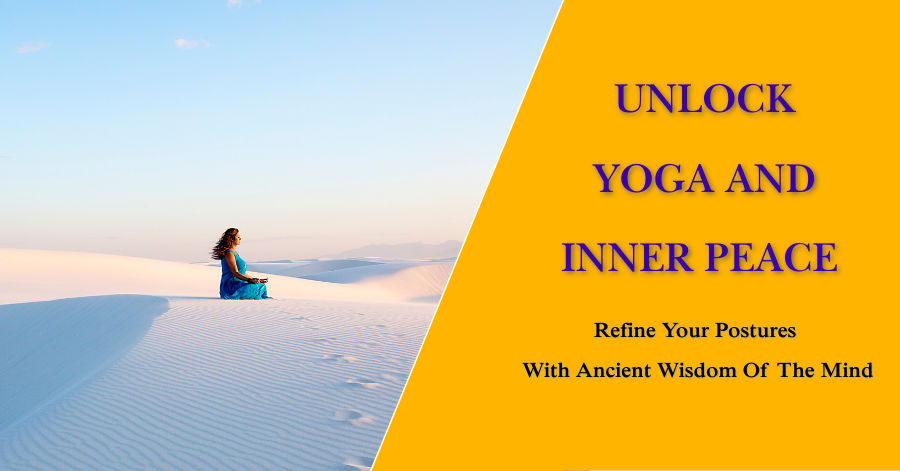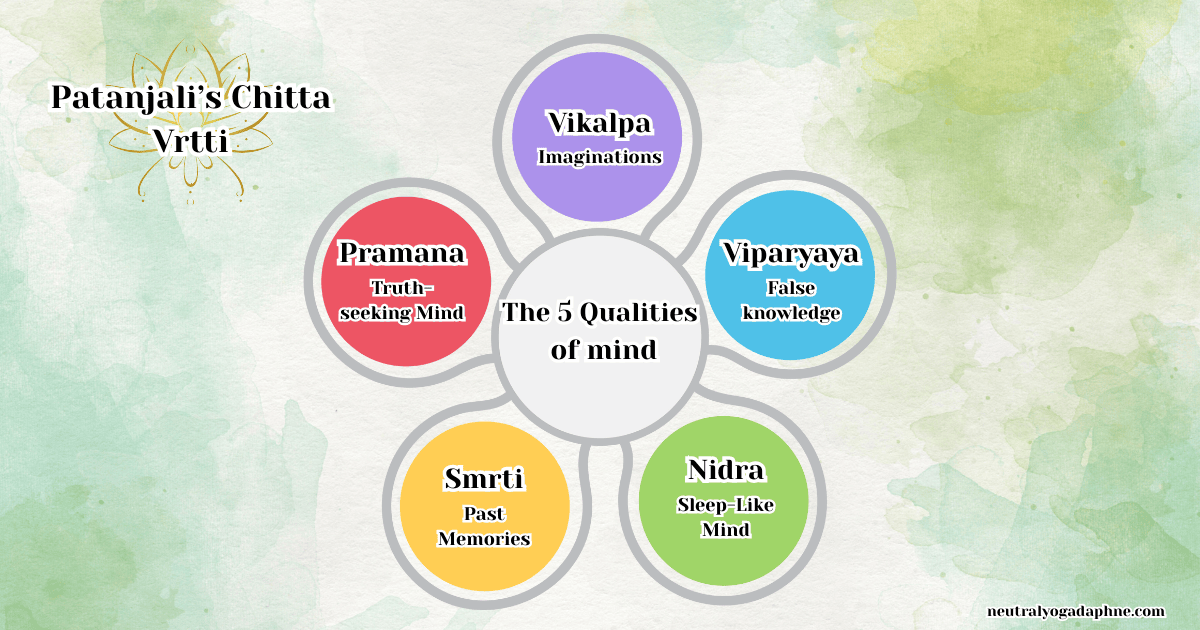Unlock Yoga And Inner Peace: Refine Your Postures With Ancient Wisdom Of The Mind

How are yoga and inner peace connected? When we think about yoga, most of us might imagine people jumping on a yoga mat balancing into funny looking poses. We consider yoga something similar to aerobic, benefiting our health and boosting weight loss. While this is one aspect of yoga, the ultimate goal of yoga is to quiet down your inner chit-chat with the aim to quiet your mind and gain inner peace.
In this article, I would like to discuss how yoga philosophy analyzes the mind and provide practical tips on how to observe and implement this concept into your daily life and yoga practice.
Yoga And Inner Peace Through The Lens Of Patanjali’s Chitta Vrtti
The father of yoga, Patanjali, had written comprehensively about the qualities of mind in his “Yoga Sutras”. Understanding these qualities nurtures yoga and inner peace. In his sutras, he introduces the concept of “chitta vrtti”. “Chitta” is the Sanskrit word for “mind” and “vrtti” means “fluctuation”.
Patanjali categorizes chitta vrtti in five classes which are pramana, viparyaya, vikalpa, nidra and smrti1 . Let’s explore how understanding these five qualities of the mind helps us to cultivate yoga and inner peace.
1. Pramana: Truth-Seeking Mind

The first one is pramana, which is the truth-seeking mind. He illustrates three ways to find out the truth.
One method is to use our five senses such as seeing, hearing, touching etc.(pratyaksa). For instance, how do we find out if apples are red or green? You find out through your sense of sight. One simple yet powerful way to find out the truth is through our five senses such as seeing, touching, hearing etc.
Another way to find out the truth is through logical reasoning (anumana). Why do we know that one plus one is two? We do this by logical thinking.
One more way to discover the truth is by gaining information from reliable resources such as a renowned authority of a particular field, teacher etc. (agama). We all know that the speed of light is the fastest thing in the universe because the Nobel Prize winner Einstein proved it.
2. Viparyaya: False Knowledge
The second state of mind viparyaya is false knowledge which the mind reckons is true. For example, people in the 19th-century believed that aliens were living on Mars. The astronomer Giovanni Schiaparelli thought he had seen canals on the planet and made the wrong assumption that it was populated by martians.
3. Vikalpa: Imaginations
The third quality vikalpa is the fantasizing or daydreaming mind not based on reality. Vikalpa can be positive or negative. A compelling example of this comes from Nakamura Tempu’s autobiography, the man who introduced yoga to Japan2. The author recounts his experience during WWⅠ when worked as an intelligence agent.
During his mission, two men were hit by a bullet, leaving both seriously injured. The first man reacted dramatically, lamenting about how bad his wound was. Contrary, the second man did not make a fuss about it. He was happy that he survived. Who do you think survived? The second man lived a fulfilling life until his natural death, whereas the first man died in several weeks. This anecdote illustrates very well how important our imaginations are.
You can utilize your imagination in a positive way to improve your yoga and inner peace.
4. Nidra: Sleep-Like Mind
The fourth state nidra is the sleeping mind. When you sleep, you do not recall your past and current experience. But your subconscious still has some effect on your mind.
5. Smrti: Past Memories
The fifth quality smrti is the mind remembering past thoughts and knowledge. Why do we know what to eat and not to eat? Because our parents have taught us for years which things are edible. It is helpful to have this knowledge.
But it can also be a hindrance. For example, I got bitten by a rabbit as a small child when I put my finger into its cage. Today, I am still a bit nervous when I touch a rabbit.
Now, how can we use these concepts to foster yoga and inner peace and implement them in our asana practice?
Fostering Yoga And Inner Peace During Yoga Practice

1. Pramana: Observe Muscles, Joints And Bones
Pramana: Whenever you do Hatha yoga postures, bring your awareness to your muscles, joints and bones. Observe how you turn your arms, which muscle you use in every single posture. Try it with Tadasana (Mountain Pose). It seems to be a very simple pose. However, if you pay attention to each detail, you notice that there is so much going on inside your body. You might feel you need to push your tailbone a lot to stand straight. I have written a detailed description about Tadasana for you. Read through the instructions and try it out.
Fostering pramana helps to focus the mind in the present which is one of the key aspects of achieving yoga and inner peace.
2. Viparayaya: Faulty Alignment Leads To Injury
Viparyaya: False knowledge about yoga postures might lead to injuries. Last time, I went to an advanced vinyasa yoga class. However, beginners also joined the class. Since it was a dynamic class, the teacher barely corrected the postures of the participants. When we were in the Warrior 1 Pose, I saw some students’ hips were not parallel to the front. If they continue with an incorrect alignment, yoga will do more harm than good.
To refine your yoga postures, find a competent teacher and learn proper alignment.
3. Vikalpa: Visualize
Vikalpa: Make use of your imagination during a yoga class to enhance your practice. During Warrior 3, when I stretch out my arms to the front, I imagine one yoga brick between my hands. This helps me to keep my arms at a proper distance.
Or while I practice pranayama (breathing technique) I imagine a green energy flow going through my nose. I imagine how I send this energy flow down into my pelvis. This image helps me to focus on the breath and inhale deeper.
For example, practice vikalpa in Trikonasana (Triangle Pose). After you have bent forward, visualize a straight wall behind your upper body. This will help you to keep your upper body parallel to the front.
Use your imagination to enhance your yoga practice. You will be able to refine your alignment, deepen relaxation and promote yoga and inner peace. If your alignment is not correct, you may feel pinching pain in your joints, become exhausted more quickly and not get the full benefit of the pose.
4. Nidra: Relax
Nidra: During Savasana (Corpse Pose) try to completely let go of your head, arms, upper body, lower body and legs. Imagine your eyeballs sinking to the back, and your body getting heavier. At the same time, keep your awareness to the whole body. And practice Savasana for about 15 to 30 minutes in one session. Savasana certainly cannot replace sleep but creates similar brainwave patterns to sleep.
Studies have shown by practicing this pose, you can improve your sleep quality, improve symptoms of depression and handle chronic pain3 . Here you can see how yoga and inner peace are connected to each other.
5. Smrti: Be In The Present
Smrti: Do not get caught in your past experience when you encounter a new pose. For instance, when I first saw the yoga teacher doing Sirsasana (Headstand) I thought “I could never do this!”.
When I was at secondary school, I had to do a handstand on a spring box during a physical education class. While I was in the handstand, I lost balance and tipped to the side resulting in a broken hand. From that day on, I had become scared of being upside down.
When I started to learn Sirsasana I thought “what will happen when I lose balance. I will hurt myself again”. Although I never tried this pose before, I was already in alert mode.
With the help of a competent Iyengar teacher I was able to overcome this fear. She prepared me step by step for this pose.
Be in the present and don’t be a prisoner of the past to nurture yoga and inner peace.

Conclusion
In this article, we looked at the five qualities of the mind defined by the sage Patanjali. He describes the truth-seeking mind, the mind fogged by false knowledge, the fantasizing mind, the mind in a deep state of unconsciousness and the mind dwelling or utilizing its past experiences. Furthermore, we have looked at how we can use these five states of mind in our yoga postures practically.
Take your yoga practice to the next level by utilising the five qualities of mind. Use pramana to look inside your body and study how your muscles and joints interact with your asana practice. Be aware of viparyaya to gain accurate knowledge of yoga asanas to avoid any injury or strain. Use vikalpa, your imagination, to fine-tune your postures. Remember to use nidra, to relax after your practice. Finally, make use of smrti and focus on the present. Do not get caught up in the past, like thinking “oh I cannot do this!” just practise and be in the moment of the practice.
I hope this article helped you to understand the connection between yoga and inner peace.
Reference

Comments